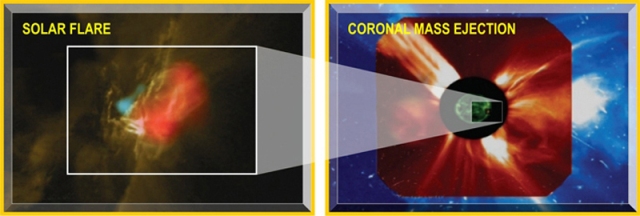Nov 19 2013
Scientists from the University of New Hampshire and colleagues have published comprehensive findings on space-based radiation as measured by a UNH-led detector aboard NASA's Lunar Reconnaissance Orbiter (LRO). The data provide critical information on the radiation hazards that will be faced by astronauts on extended missions to deep space such as those to Mars.
 Solar flare observed by the Reuven Ramaty High Energy Solar Spectroscopic Imager and associated coronal mass ejection observed by the Solar and Heliospheric Observatory spacecraft. Solar energetic particles from these events can easily penetrate typical shielding and damage spacecraft electronics and biological cells. Image courtesy of Nathan Schwadron, UNH-EOS.
Solar flare observed by the Reuven Ramaty High Energy Solar Spectroscopic Imager and associated coronal mass ejection observed by the Solar and Heliospheric Observatory spacecraft. Solar energetic particles from these events can easily penetrate typical shielding and damage spacecraft electronics and biological cells. Image courtesy of Nathan Schwadron, UNH-EOS.
The papers in a special issue of the journal Space Weather document and quantify measurements made since 2009 by the Cosmic Ray Telescope for the Effects of Radiation (CRaTER) radiation detector.
"These data are a fundamental reference for the radiation hazards in near Earth 'geospace' out to Mars and other regions of our sun's vast heliosphere," says CRaTER principal investigator Nathan Schwadron of the UNH Institute for the Study of Earth, Oceans, and Space (EOS).
The space environment poses significant risks to both humans and satellites due to harmful radiation from galactic cosmic rays and solar energetic particles that can easily penetrate typical shielding and damage electronics. When this radiation impacts biological cells, it can cause an increased risk of cancer.
Before CRaTER's long-term radiation measurements were derived using a material called "tissue-equivalent plastic"—a stand-in for human muscle capable of gauging radiation dosage—those hazards were not sufficiently well characterized to determine if long missions outside low-Earth orbit can be accomplished with acceptable risk.
CRaTER's seminal measurements now provide quantified, radiation hazard data from lunar orbit and can be used to calculate radiation dosage from deep space down to airline altitudes. The data will be crucial in developing techniques for shielding against space-based radiation dosage. The measurements have also played a vital role in UNH space scientists' efforts to develop both the first Web-based tool for predicting and forecasting the radiation environment in near-Earth, lunar, and Martian space environments and a space radiation detector that possesses unprecedented performance capabilities.
The near real-time prediction/forecasting tool known as PREDICCS integrates for the first time numerical models of space radiation and a host of real-time measurements being made by satellites currently in space. It provides updates of the radiation environment on an hourly basis and archives the data weekly, monthly, and yearly— an historical record that provides a clear picture of when a safe radiation dose limit is reached for skin or blood-forming organs, for example.
CRaTER offers an opportunity to test the capability of PREDICCS to accurately describe the lunar radiation environment. The Space Weather special issue provides comparisons between dose rates produced by PREDICCS with those measured by CRaTER during three major solar energetic particle events that occurred in 2012.
The detector developed at UNH, known as DoSEN, short for Dose Spectra from Energetic Particles and Neutrons, measures and calculates the absorbed dose in matter and tissue resulting from the exposure to indirect and direct ionizing radiation, which can change cells at the atomic level and lead to irreparable damage. Schwadron is lead scientist for both the PREDICCS and the DoSEN project.
"DoSEN is an innovative concept that will lead to a new generation of radiation detectors, or dosimeters, to aid in understanding the hazards posed by the radiation environment of space," says Schwadron. "The ability to accurately understand these hazards will be critical to protect astronauts sent beyond low-Earth orbit on extended space missions."
DoSEN combines two advanced, complementary radiation detection concepts that present fundamental advantages over traditional dosimetry. The dosimeter measures both the energy and the charge distribution of energetic particles that affect human and robotic health in a way not presently possible with current technology. Protons, heavy ions, and neutrons all contribute significantly to the radiation hazard.
"Understanding how different particles such as neutrons and heavy ions pose hazards will be extremely important in completely characterizing the types of environments we will operate in," Schwadron says. "For example, on the moon, there are additional hazards from neutrons that are created by high-energy radiation interacting in the lunar soil and radiating outward from the surface."
That "backsplash" of protons, which was discovered by CRaTER and is known as the moon's radiation "albedo," is caused by the partial reflection of galactic cosmic rays off the moon's surface. This creates a surprising one-two punch of deadly radiation and can also be used to peer below the lunar surface like a geological probe.
Says Harlan Spence, CRaTER deputy lead scientist and director of EOS, "Until now, people have not had the 'eyes' necessary to see this particular population of particles. With CRaTER, we just happen to have the right focus to make these discoveries."